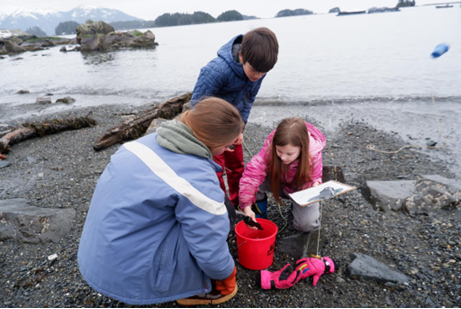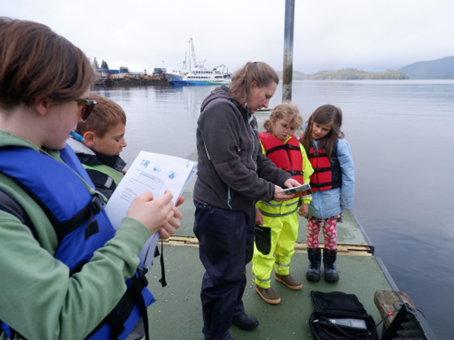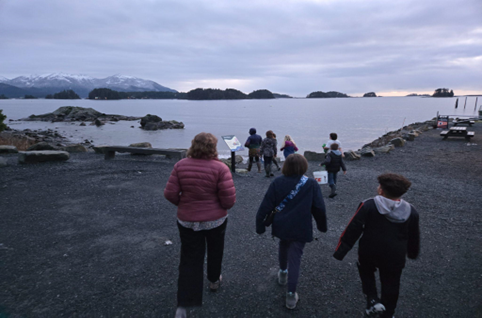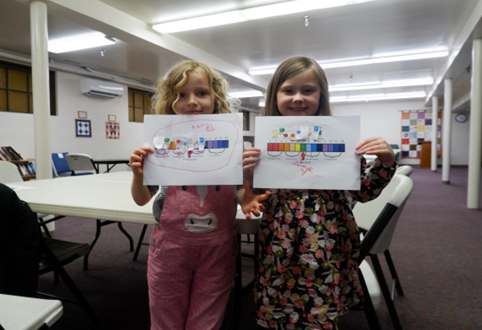Stars and STEM Stories
GLOBE United States: Ocean Acidification Education with 4-H Youth in Alaska (4-H pH)
Ocean acidification, the gradual decline in seawater pH caused by rising atmospheric carbon dioxide, is happening globally. Waters around Lingít Aaní, southeast Alaska and home to Sheet’ká (Sitka), are acidifying faster than the global average. This rapid change has prompted several organizations to monitor the changing chemistry. Among them is Natalie Monacci, a chemical oceanographer at the University of Alaska Fairbanks and director of the Ocean Acidification Research Center. Monacci collaborates with federal agencies such as the National Oceanic and Atmospheric Administration (NOAA), nonprofits, Tribes, and fishers to track long-term change. These ocean measurements are integrated with marine ecosystem and fisheries data to prove a more complete picture of environmental impacts. Monacci also serves as the principal investigator of a new NOAA-funded project that uses GLOBE to monitor ocean acidification in Sheet’ká.

Youth take measurements at Sage Beach (February 2025).
Like many coastal regions, Lingít Aaní’s cultural and economic well-being is deeply connected to the ocean. Ocean change threatens this balance, potentially affecting food security and traditional practices. In response, the Sheet’ká Kwáan, Sitka Tribe of Alaska, leads a program that monitors natural resources across their territories, including ocean acidification. Together, these collaborative efforts inform decision makers, helping guide the management of subsistence and commercial fisheries while assessing ecological and community risks.
Natalie Monacci, Christina Buffington, Jasmine Shaw, and Simone Alin led a new project, 4-H pH, an ocean education program with Sitka youth this past winter and funded by NOAA’s Ocean Acidification Program. Students enrolled in the Sitka 4-H afterschool program, led by Shaw and the Cooperative Extension Service of the University of Alaska Fairbanks, used GLOBE protocols to monitor seawater pH, temperature, and dissolved oxygen from January through April of 2025, in an attempt to learn about local ocean acidification. Buffington and Shaw have worked with local youth in Sitka, Alaska, on GLOBE projects for 8 years. Alin is a carbonate chemistry expert at NOAA’s Pacific Marine Environmental Laboratory.
The 4-H pH project demonstrates that students as young as elementary school can conduct ocean chemistry monitoring with high-quality data alongside Tribal monitoring professionals and research scientists. The youth compared their GLOBE data to regional ocean chemistry data from a research cruise Monacci helped lead in 2022. The cruise data are public at NOAA NCEI Ocean Carbon and Acidification Data System (OCADS) and are now linked to the youth led GLOBE data and sovereign Tribal data.

Students collect ocean data and fill out GLOBE data sheets alongside Nicole Filipik, Sitka Tribe of Alaska Environmental Lab Analyst (March 2025).
Students thought that collecting GLOBE ocean data on the beach is like having a party. One 4-H pH student’s mother described her son as follows: “He came home very excited. He said, ‘We can’t go to Hawaii anymore ‘cause I’m never missing 4-H again.’” He went on to tell her that he has to always be there so he can go to the “beach party with snacks, stickers, and other fun stuff.”
GLOBE helps NASA and NOAA leverage local community partnerships to be the eyes on local and global issues, such as ocean acidification. Through local partners, like the Sitka Sound Science Center, GLOBE students have a space to dip their buckets in the sea at Sage Beach and to envision the future. It’s a blue planet, monitor the ocean!
Anyone can see the 4-H pH GLOBE beach site and the Sitka Sound Science Center through a youth-made virtual tour made available by a NASA Science Activation program called Infiniscope, viewable at this Virtual Tour link.
View the 4-H pH GLOBE data.
Partners in the region have expressed a strong interest in an education program that introduces STEM training at an early age. The 4-H program, built on the values of Head, Heart, Hands, and Health, empowers youth with lifelong leadership skills. This summer, 4-H pH will be held in two southeast Alaska communities, Angoon and Petersburg, so stay tuned for more 4-H pH data in GLOBE!
See more images below.

4-H elementary students head to Sage Beach in Sitka, Alaska, for ocean chemistry data collection (January 2025).

Students learn about the pH scale (March 2025).

4-H youth experiment with acids and bases in the kitchen during a cooking lesson (March 2025).
Learn more about GLOBE United States.
Story courtesy of Christina Buffington, science education director; Natalie Monacci, chemical oceanographer, and Jasmine Shaw, 4-H program assistant, University of Alaska Fairbanks.
Photos courtesy of Christina Buffington and Jasmine Shaw.
Funding for 4-H pH: Ocean Acidification Education in Alaska is through a NOAA Ocean Acidification Program mini-grant (Grant Award # NA24OARX017G0014-T1-01). The University of Alaska Fairbanks GLOBE Partner provides additional 4-H support through the Arctic and Earth STEM Integrating GLOBE and NASA (SIGNs) project (NASA Grant Award # NNX16AC52A).





